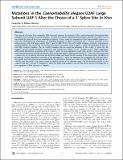| dc.contributor.author | Ma, Long | |
| dc.contributor.author | Horvitz, Howard Robert | |
| dc.date.accessioned | 2010-03-10T19:48:13Z | |
| dc.date.available | 2010-03-10T19:48:13Z | |
| dc.date.issued | 2009-11 | |
| dc.date.submitted | 2009-05 | |
| dc.identifier.issn | 1553-7390 | |
| dc.identifier.issn | 1553-7404 | |
| dc.identifier.uri | http://hdl.handle.net/1721.1/52478 | |
| dc.description.abstract | The removal of introns from eukaryotic RNA transcripts requires the activities of five multi-component ribonucleoprotein complexes and numerous associated proteins. The lack of mutations affecting splicing factors essential for animal survival has limited the study of the in vivo regulation of splicing. From a screen for suppressors of the Caenorhabditis elegans unc-93(e1500) rubberband Unc phenotype, we identified mutations in genes that encode the C. elegans orthologs of two splicing factors, the U2AF large subunit (UAF-1) and SF1/BBP (SFA-1). The uaf-1(n4588) mutation resulted in temperature-sensitive lethality and caused the unc-93 RNA transcript to be spliced using a cryptic 3′ splice site generated by the unc-93(e1500) missense mutation. The sfa-1(n4562) mutation did not cause the utilization of this cryptic 3′ splice site. We isolated four uaf-1(n4588) intragenic suppressors that restored the viability of uaf-1 mutants at 25°C. These suppressors differentially affected the recognition of the cryptic 3′ splice site and implicated a small region of UAF-1 between the U2AF small subunit-interaction domain and the first RNA recognition motif in affecting the choice of 3′ splice site. We constructed a reporter for unc-93 splicing and using site-directed mutagenesis found that the position of the cryptic splice site affects its recognition. We also identified nucleotides of the endogenous 3′ splice site important for recognition by wild-type UAF-1. Our genetic and molecular analyses suggested that the phenotypic suppression of the unc-93(e1500) Unc phenotype by uaf-1(n4588) and sfa-1(n4562) was likely caused by altered splicing of an unknown gene. Our observations provide in vivo evidence that UAF-1 can act in regulating 3′ splice-site choice and establish a system that can be used to investigate the in vivo regulation of RNA splicing in C. elegans. | en |
| dc.description.sponsorship | National Institutes of Health (Grant GM24663) | en |
| dc.language.iso | en_US | |
| dc.publisher | Public Library of Science | en |
| dc.relation.isversionof | http://dx.doi.org/10.1371/journal.pgen.1000708 | en |
| dc.rights | Creative Commons Attribution | en |
| dc.rights.uri | http://creativecommons.org/licenses/by/2.5/ | en |
| dc.source | PLoS | en |
| dc.title | Mutations in the Caenorhabditis elegans U2AF Large Subunit UAF-1 Al= of a 3' Splice Site In Vivo | en |
| dc.type | Article | en |
| dc.identifier.citation | Ma, Long, and H. Robert Horvitz. “Mutations in the Caenorhabditis elegans U2AF Large Subunit UAF-1 Alter the Choice of a 3′ Splice Site In Vivo.” PLoS Genet 5.11 (2009): e1000708. | en |
| dc.contributor.department | Massachusetts Institute of Technology. Department of Biology | en_US |
| dc.contributor.approver | Horvitz, H. Robert | |
| dc.contributor.mitauthor | Ma, Long | |
| dc.contributor.mitauthor | Horvitz, H. Robert | |
| dc.relation.journal | PLoS Genetics | en |
| dc.eprint.version | Final published version | en |
| dc.type.uri | http://purl.org/eprint/type/JournalArticle | en |
| eprint.status | http://purl.org/eprint/status/PeerReviewed | en |
| dspace.orderedauthors | Ma, Long; Horvitz, H. Robert | en |
| dc.identifier.orcid | https://orcid.org/0000-0002-3925-9154 | |
| dc.identifier.orcid | https://orcid.org/0000-0002-9964-9613 | |
| mit.license | PUBLISHER_CC | en |
| mit.metadata.status | Complete | |
